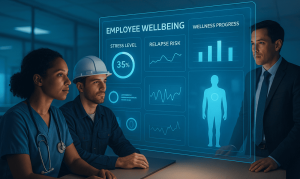In today’s business environment, organizations that truly embrace difference gain an adaptive edge. One key frontier is how we support employees whose brains work differently, those who are neurodivergent.
Implementing AI for neurodiversity initiatives invites a shift: from accommodation as a reactive cost to inclusion as a strategic advantage.
Below, we explore how advanced technologies such as AI wellness coaching, adaptive communication AI, autism support AI and ADHD AI coaching can help businesses create environments where neurodiverse talent thrives.
Why neurodiversity matters in the workplace
Research suggests up to 15-20 % of the global population may be neurodivergent (for example autism, ADHD, dyslexia).
Yet many companies are still only beginning to realise the business impact of this group. For example:
- Teams with neurodivergent professionals in some roles can be as much as 30 % more productive than teams without them.
- Only about 52 % of employers say there is general workforce awareness of what neurodiversity is and why it matters. CIPD
- Many neurodivergent employees report micro-aggressions or feeling unsupported in workplace settings.
These figures tell a simple story: neurodiverse employees often bring unique strengths (e.g., pattern recognition, hyper-focus, attention to detail) but are still under-supported. From a business owner’s perspective, that is both a risk and an opportunity.
How AI is shaping inclusive support for neurodiverse talent
When we talk about AI for neurodiversity, we’re looking at how tools powered by artificial intelligence can help bridge the gap between potential and performance for neurodiverse workers. Below are some of the key areas where this is playing out.
1. ADHD AI coaching
Employees with ADHD may struggle with attention regulation, task-switching or sustaining focus. AI-driven coaching platforms can help by:
- Monitoring workflow and suggesting micro-breaks or changes in task rhythm.
- Providing personalised prompts or reminders to structure tasks into manageable chunks.
- Offering data-driven insights about when focus dips and recommending environment adjustments.
By embedding this kind of employee wellbeing solutions, the business empowers the employee—not by lowering standards but by offering the right scaffolding.
2. Autism support AI
For employees on the autism spectrum, the challenges often lie in communication nuance, sensory overload or non-typical interaction styles. Autism support AI can assist by:
- Translating complex or ambiguous requests into clear, structured action steps.
- Offering real-time feedback or preparation tools before meetings (e.g., anticipating social context, questions).
- Adjusting the digital environment (e.g., interface simplification, personalised sensory settings) based on user preferences.
This kind of adaptive support helps reduce cognitive friction and fosters a more inclusive environment.
3. Neuro-inclusive workplace AI
Creating a truly neuroinclusive workplace means more than one-off accommodations, it means systemic design. AI contributes in several ways:
- Adaptive communication AI: Platforms that adjust language complexity, deliver notifications in preferred formats (visual/audio/text) and tailor formatting based on user profile.
- Digital accessibility AI: Built-in features that automatically detect when a worker may need alternative formats (e.g., dyslexia-friendly fonts, captioning) or suggest adjustments.
- Workflow analytics: AI engines that monitor task distribution, interaction patterns, and flag environment stressors (e.g., open-plan noise, meeting overload) that disproportionately affect neurodivergent employees.
By embedding such tools, the organisation moves from “we will accommodate if requested” to “we design for difference proactively”.
4. Cognitive coaching AI
Cognitive coaching AI supports employees’ internal processes planning, prioritising, memory recall, self-monitoring. Examples:
- AI systems that help break down ambiguous instructions into clear milestones.
- Tools that summarise long documents or highlight key points for workers who may struggle with sustained reading or distraction.
- Feedback loops: The system tracks what kinds of tasks cause friction and offers suggestions for process redesign.
These tools assist neurodiverse employees to bring their best selves to work, while also giving managers insight into how to support rather than micromanage.
Why business leaders should prioritise AI for neurodiversity
Here are several compelling reasons:
- Talent pipeline strength: With tight talent markets, tapping into the neurodiverse workforce expands your pool and unlocks hidden potential.
- Innovation boost: Diverse thinking leads to better outcomes. The research showing up to 30 % higher productivity with neurodiverse teams is a compelling business case.
- Employee retention & engagement: Neurodiverse employees who feel supported are more likely to stay and contribute actively. Without support, many take leave or exit.
- Reputation & culture: Demonstrating inclusion builds your employer brand, but also aligns with the values of younger generations who expect purpose-driven workplaces.
- Risk mitigation: Not supporting neurodiverse talent can lead to productivity drag, higher turnover, and potential legal or reputational risks.
A practical roadmap for implementing AI-driven support
Here is a practical framework you can follow:
- Assess current state
- Conduct employee surveys to understand the neurodiversity climate (e.g., is language inclusive? Do people feel they can disclose safely?).
- Audit your systems: Do communication tools include accessibility features? Are your workflows flexible?
- Conduct employee surveys to understand the neurodiversity climate (e.g., is language inclusive? Do people feel they can disclose safely?).
- Define needs and priorities
- Identify key areas of friction for neurodiverse staff (for example, sensory overload, unclear instructions, workflow interruptions).
- Decide which AI tools align best with your company size and culture: e.g., cognitive coaching AI, adaptive communication AI, digital accessibility AI.
- Identify key areas of friction for neurodiverse staff (for example, sensory overload, unclear instructions, workflow interruptions).
- Select and integrate technology
- Choose platforms that support flexibility, user profiling and adaptation (not just one-size-fits-all).
- Integrate into existing workflows rather than adding isolated tools—this ensures adoption.
- For example, if your organisation already uses scheduling/meetings automation, you may link certain accessibility prompts to it (parallel concept to your AI appointment scheduling capabilities).
- Choose platforms that support flexibility, user profiling and adaptation (not just one-size-fits-all).
- Train leadership & staff
- Equip managers and team leads with understanding of neurodiversity and how AI can support inclusion.
- Ensure technology is accompanied by policy: safe disclosure, flexible work options, sensory-friendly spaces.
- Equip managers and team leads with understanding of neurodiversity and how AI can support inclusion.
- Monitor and iterate
- Track metrics (employee engagement, retention of neurodiverse staff, complaint/case resolution, productivity).
- Use data from AI systems (with consent and privacy safeguards) to understand trends.
- Adjust systems and workflows based on what your data reveals.
- Track metrics (employee engagement, retention of neurodiverse staff, complaint/case resolution, productivity).
- Embed in culture
- Make neuro-inclusive design part of project-planning and tool-selection.
- Use your AI voice agent or other conversational AI to collect feedback from neurodiverse employees, in formats they prefer (audio, text, visual).
- Celebrate neurodivergent strengths and promote stories of success.
- Make neuro-inclusive design part of project-planning and tool-selection.
Common pitfalls and how to avoid them
- Assuming one size fits all: Neurodiversity covers a wide range of conditions—what works for one person may hinder another. Customisation is key.
- Using AI without choice: If employees feel tools are imposed without consultation, trust can erode. Involve neurodiverse team members in selection and rollout.
- Ignoring the human system: Technology is only part of the solution. Culture, policy, leadership behaviour are equally important.
- Data and privacy concerns: Monitoring workflows and cognitive profiles must be done ethically, transparently and with clear consent.
- Neglecting communication formats: For example, chat-bots or voice systems may exclude someone who prefers visual prompts—thus adaptive communication AI is essential.
Example scenarios where AI makes a difference
- A software engineer with ADHD uses a cognitive coaching AI tool to break her sprint tasks into focused bursts, track concentration drop-zones and receive tailored prompts when attention drifts. The result: fewer missed deadlines, better planning and increased job satisfaction.
- A customer-service team member with autism uses an adaptive communication AI interface which converts customer transcripts into key action-items, highlights next steps and suggests when to ask clarifying questions. She feels less anxious, more productive and more connected to the team.
- A project manager monitors workflow alerts via digital accessibility AI which flags when open-plan noise or overheated meetings may be impacting neurodiverse staff; the team then experiments with quieter breakout zones and fewer back-to-back calls.
Looking ahead: the future of inclusive AI strategies
As businesses adopt more advanced AI, the potential for supporting neurodiversity will expand:
- AI systems will become more context aware, adapting real-time to employee states (focus, stress, sensory load).
- Tools will integrate more deeply with employee lifecycle systems: onboarding, performance review, mentoring, and adaptive career paths.
- From a strategic perspective, neuro-inclusive AI will no longer be a “nice to have” but a differentiator in talent strategy, especially as younger generations increasingly identify as neurodivergent.
For business leaders, the message is clear: adopting AI for neurodiversity is less about gimmicks and more about unlocking talent, improving resilience and building a future-ready workforce.
Key take-aways
- Up to 20 % of people are estimated to be neurodivergent—creating a significant talent pool.
- Neurodiverse teams can offer enhanced productivity, innovation and resilience.
- AI tools (such as ADHD AI coaching, autism support AI, cognitive coaching AI, adaptive communication AI) enable tailored support and inclusion.
- Implementation requires technology + culture + leadership commitment.
- Monitoring, customisation, and ethical practices are critical for success.
If you lead a business and aim to create a more inclusive, high-performing organisation, embracing AI for neurodiversity is a strategic step—not just for compliance or ethics, but for unlocking real business value.





